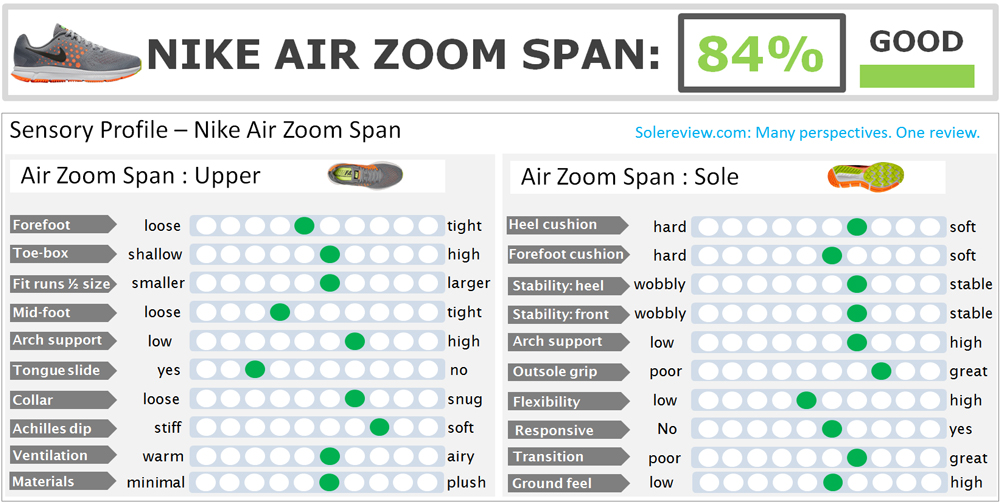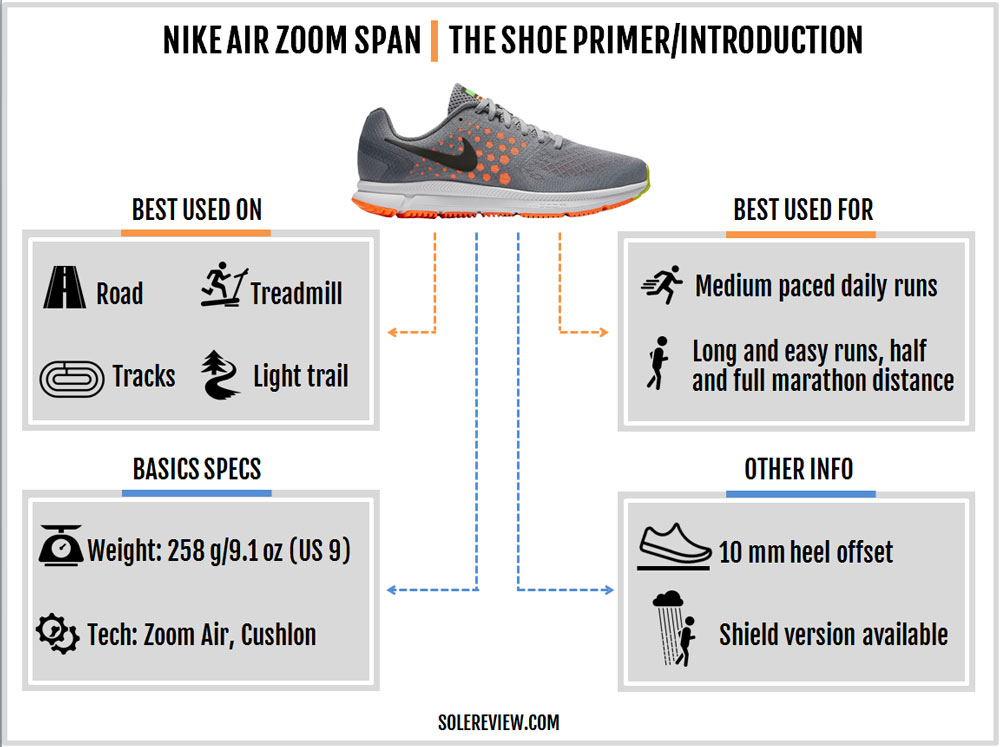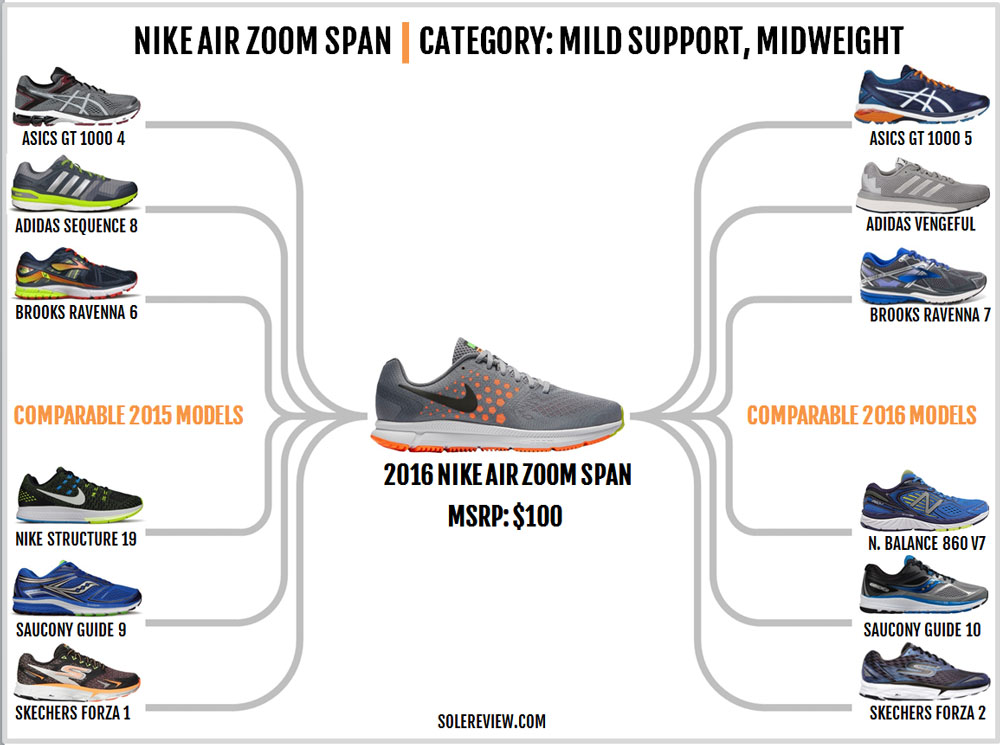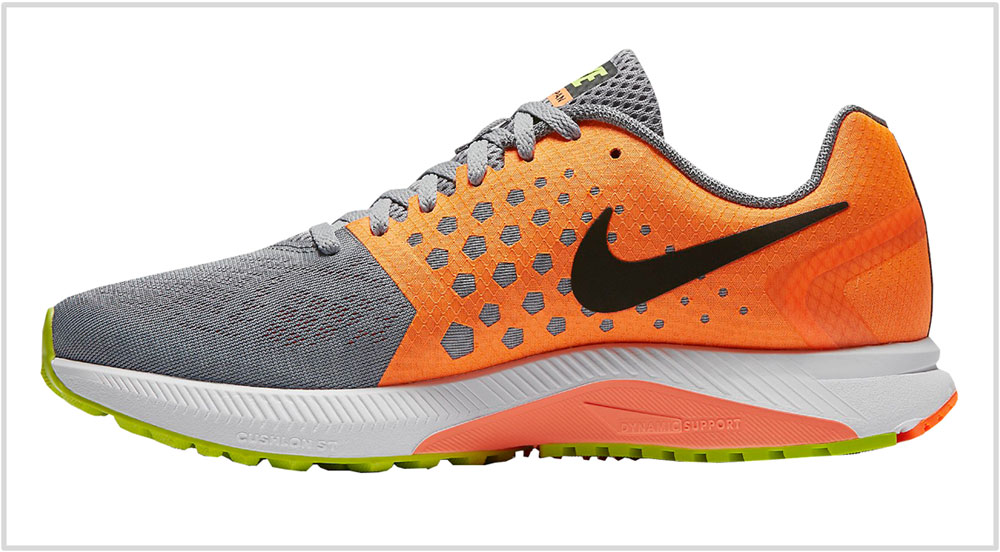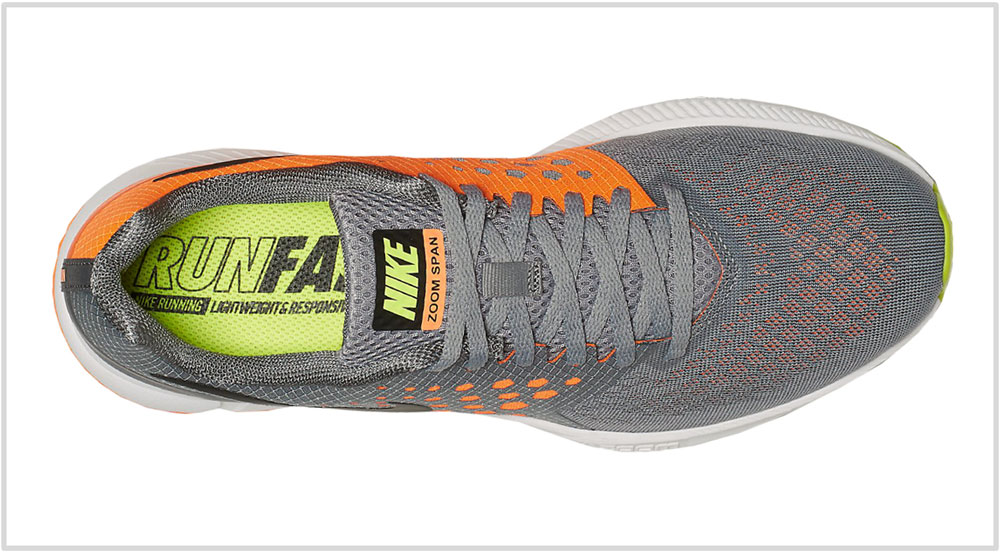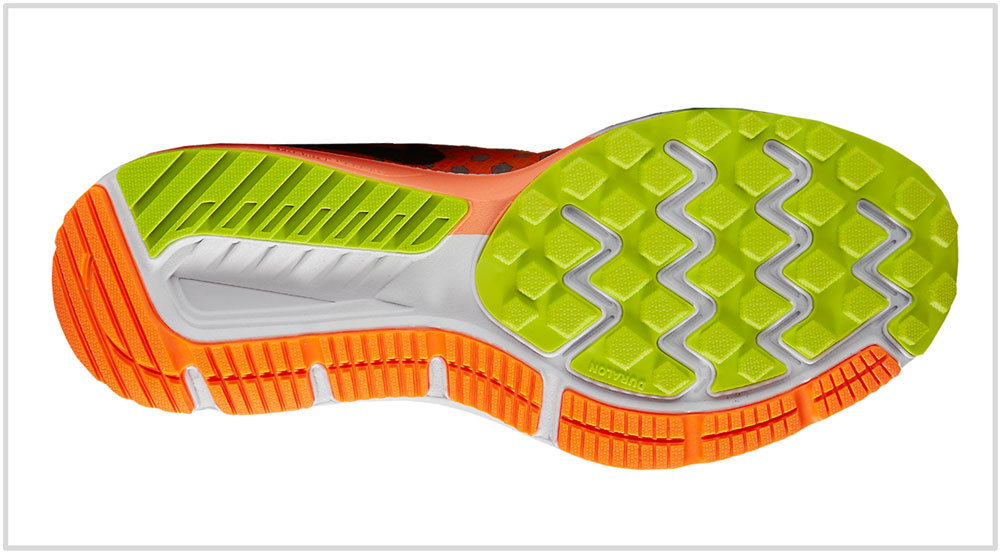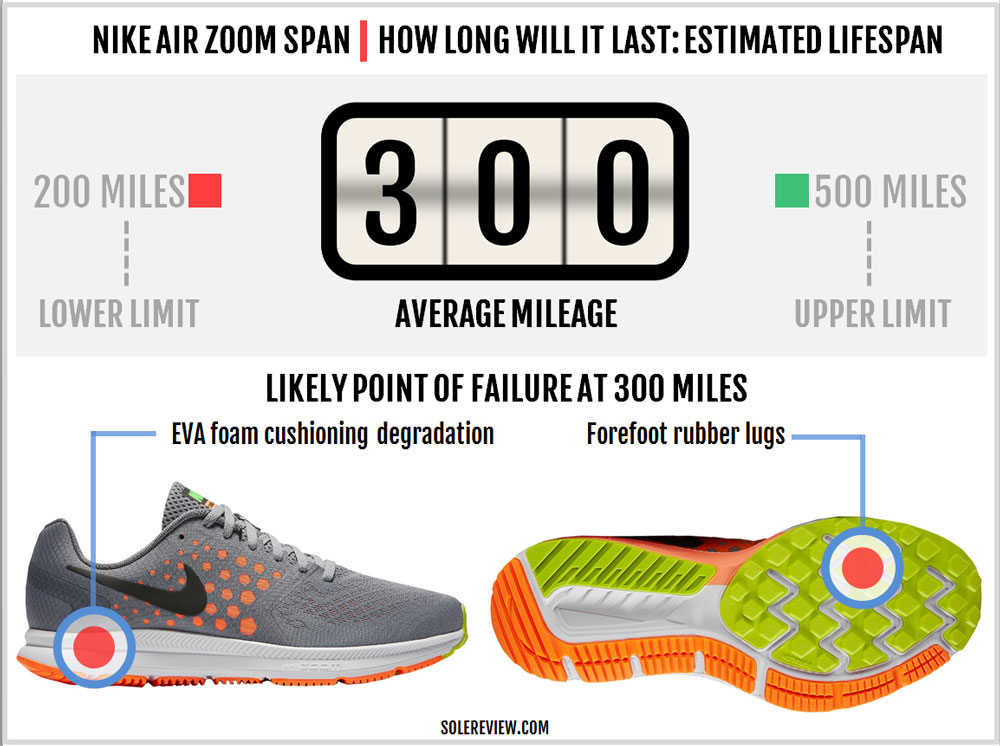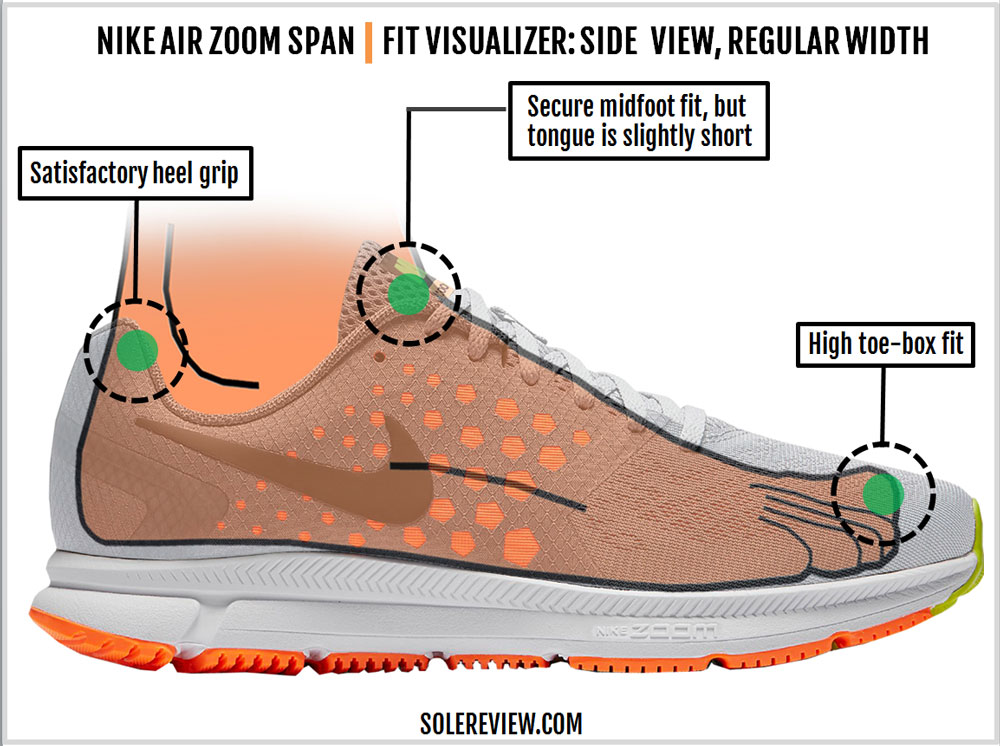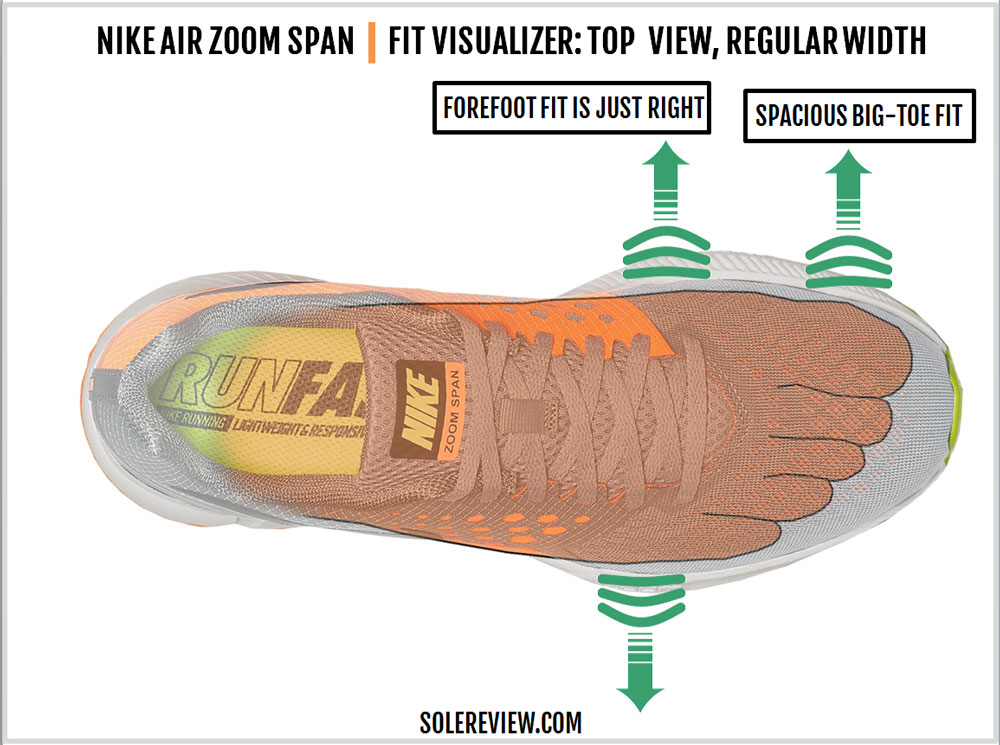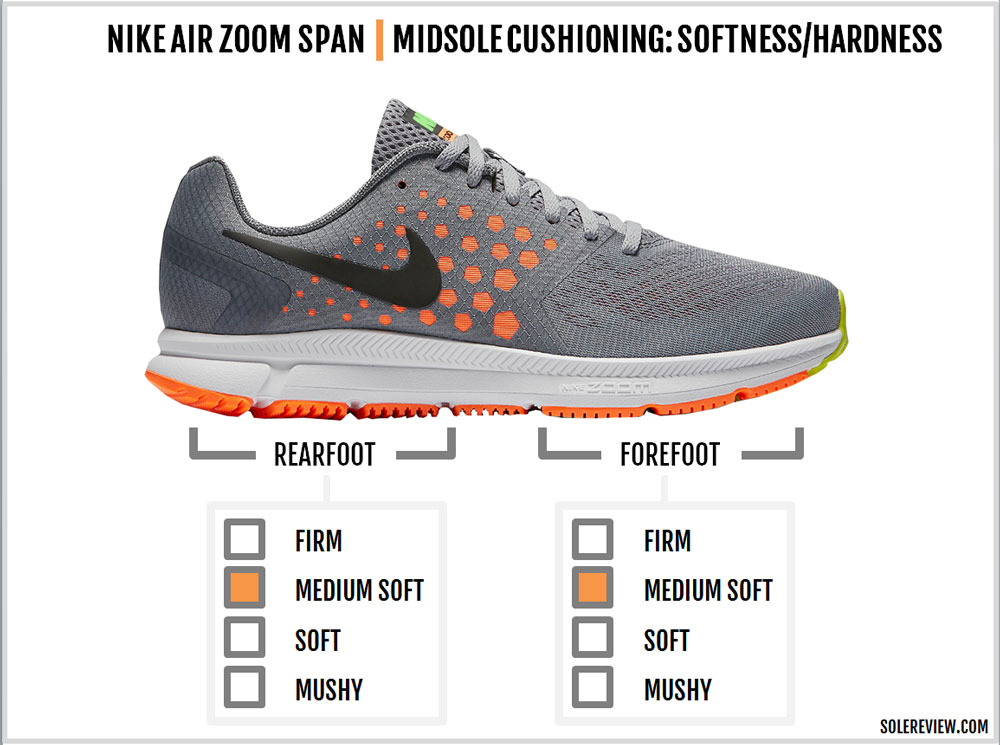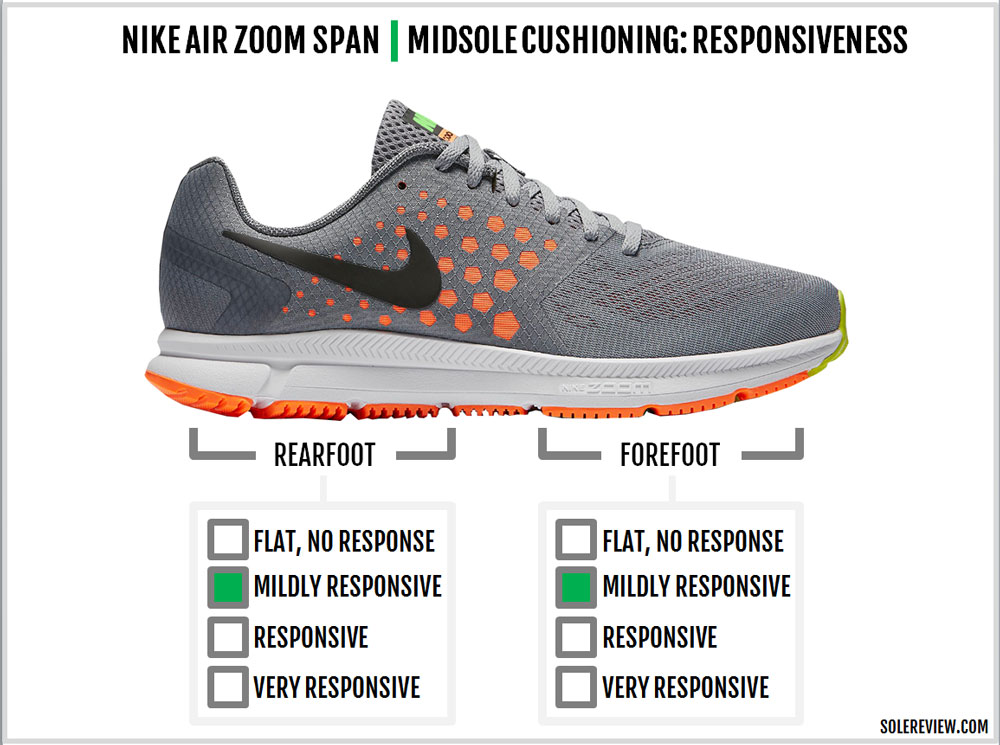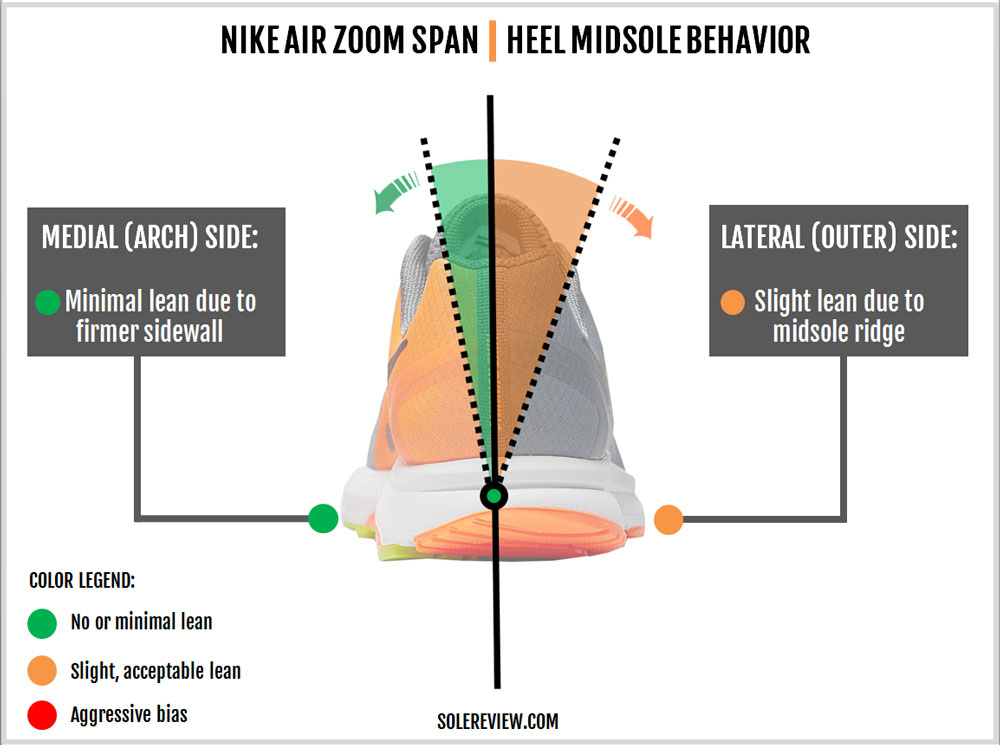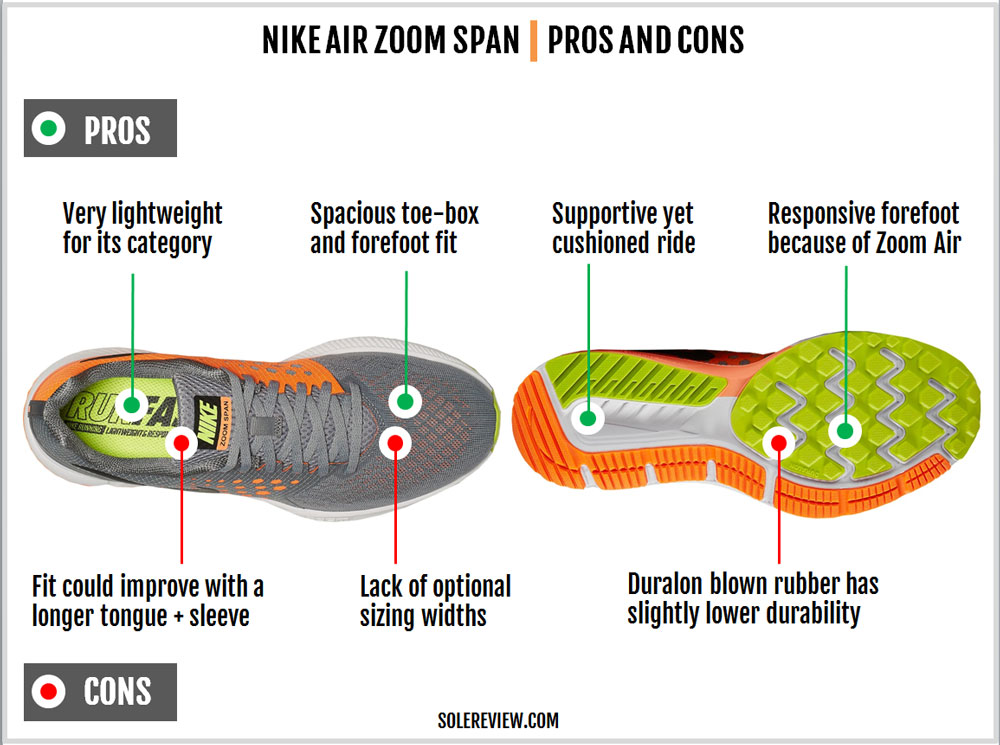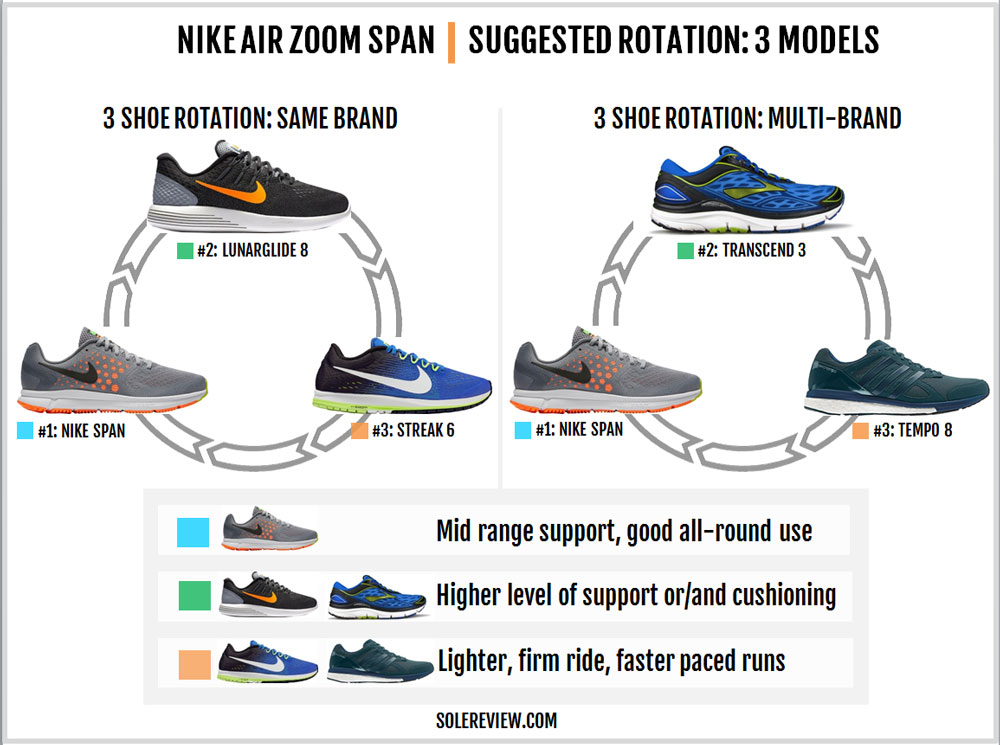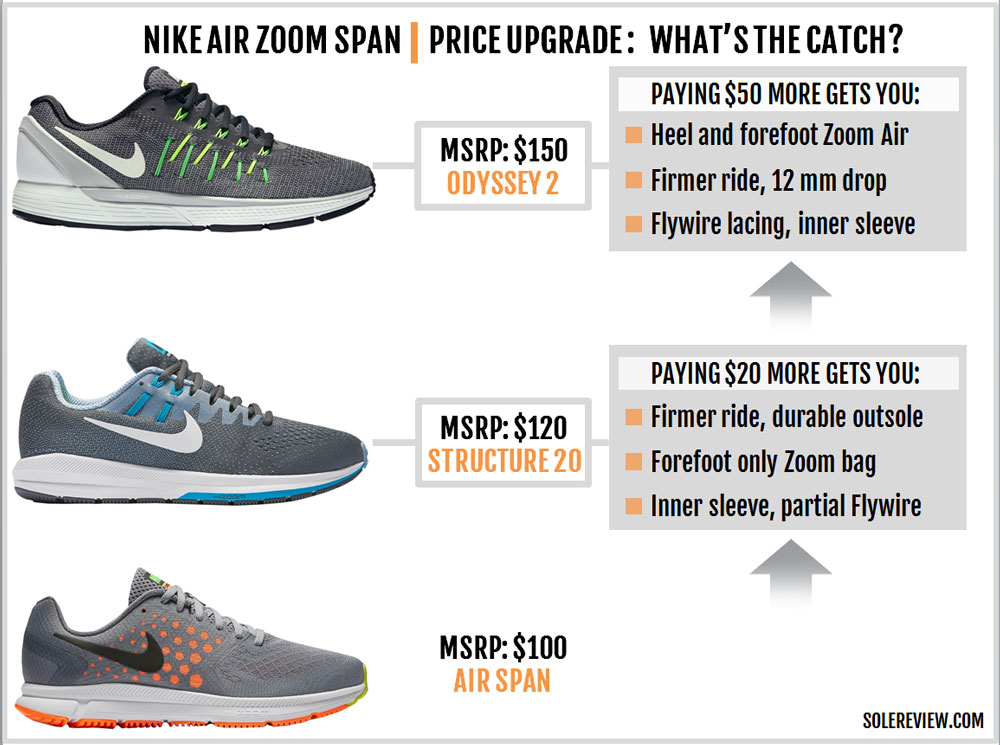INTRODUCTION
The Nike Air Zoom Span is back after a hiatus of four years. Kind of.
For nearly a decade, the Nike Structure – Span pairing was a familiar one. The Structure was a support shoe with a larger medial post, while the Span offered a milder version of medial side support.
This cozy arrangement continued swimmingly till 2011. But once the Lunarglide and its variants picked up steam, the long-standing partnership between the Structure and Span was broken. If our memory serves right, then the 2011-2012 Nike Air Span 8 was the last of its kind.
The Span returns in name and spirit for the Holiday season. The lack of a numerical suffix indicates a nomenclature reset; the new shoe is called just the Air Zoom Span. It is also an entirely different shoe than the earlier Span(s), the same way how the new Structure 20 differs from its predecessors.
Instead of the regular Air bag located under the heel (like the Span 8), the 2017 Nike Span gets a forefoot Zoom Air bag. Compared to the older Spans, it is a lighter and softer riding shoe with a smaller medial post design.
The new Span just weighs 9.1 ounces (vs. 11.2 ounces of the Structure), without any visible compromise in construction. And like many shoes designed for a wider audience, the midsole has a 10 mm heel-to-toe offset.
For long, there has been a misconception that adidas and Nike shoes are more expensive than the rest. If by other brands, you mean Asics, Brooks, Saucony, Mizuno and New Balance, then that simply isn’t true. Even Skechers, the once undisputed king of sub-$100 running shoes, has upped their pricing game into triple digits.
The publicly-held perception has been founded on overhyped product releases such as the Yeezy Boost and self-tying sneakers. Take that away, and one would discover that the bread-and-butter assortment of these two brands is priced sensibly.
The $100 Nike Air Zoom Span is proof. For a price-band which is getting less frequented by the day, Nike offers a lightweight package which strings together ride comfort, support and its signature cushioning tech. Functionally, the Span is more versatile than you think, which only makes its case stronger.
Even adidas has great value in the form of the $100 Response 3 Boost. Review to follow shortly.
You might be surprised to know that Nike even has a $75 running shoe called the Winflo 3. Though not of the same price, it can be viewed as the neutral version of the Span. Like the latter, the Winflo is equipped with Zoom Air and a soft Cushlon midsole.
Cobbling together a comparison chart for the Nike Air Zoom Span isn’t a straightforward affair for two reasons. There aren’t many $100 running shoes from the competition; even Skechers sells its GoRun Forza 2 at a princely sum of $120.
Secondly, as a result of the small medial post, the Zoom Span ends up being a different product than many of the $110-125 running shoes listed here. But for whatever it is worth, we’ll do a quick round-up here, and hope that we do a good job at explaining the differences.
At an MSRP of $110, the adidas Vengeful’s price is a close match to the Span. However, we don’t think highly of the Vengeful.
The Vengeful has a large Stableframe EVA block which runs nearly the entire length of the medial midsole; this makes the ride laterally biased and unstable.
The $100 Asics GT-1000 5 is priced the same as the Span and has a similar design intent. The medial post is small and unnoticed (functionally) for the most part, which makes the GT suitable for a large group of runners.
That said, the GT-1000 5 is a much heavier shoe at 10.4 ounces, and it also runs firmer than the Span. The GT-1000 5’s material package is built to a cost, and it shows.
The Saucony Guide 10 and the New Balance 860 V7 are also different by way of a larger medial post which gives them a greater ‘motion control’ character than the Span. These models are also priced higher and possess more weight than the Span.
So what’s left are the Brooks Ravenna and the Skechers GoRun Forza 2. These two models, while priced $20 higher than the Span, are the closest match in ride experience.
Like the Zoom Span, neither the Ravenna or the Forza are overzealous in their interpretation of the medial post. The Forza has a cushioned midsole with a non-invasive medial post; the Ravenna 7 does not use a medial post at all. At least not in the traditional sense.
The result is that both these shoes – the Forza 2 and the Ravenna – exhibit a near-neutral ride behavior, a trait which the Zoom Span shares too. We feel it important to highlight that the Ravenna 7 fits much narrower than the relatively spacious Zoom Span, so make a mental note of that.
Besides the Span, Nike has another support shoe in the shape of the $85 Lunarstelos. The Stelos does not have a medial post but uses a soft Lunarlon core within a firmer foam midsole to center the foot.
We don’t get the price-value maths here though. Why does Nike charge $100 for the Zoom Span, whereas the equally well-equipped Winflo 3 and the LunarStelos are priced $25 and $15 lower respectively?
A $100 price is undoubtedly value for money, but Nike’s tiering formula doesn’t quite add up – unless we’re missing something here.
DESIGN AND MATERIALS
One quick look at the Span and your brain instantly registers the visual association with the Nike Pegasus 31. The Span has midfoot panels with pentagon-shaped windows, the Swoosh logos are placed with a rearfoot biased orientation, and the forefoot is made of an engineered mesh.
Below, the prominent midsole ridge is a visual reminder of the similar Pegasus 31 design. While the Span is clearly inspired by the Pegasus 31’s aesthetic language, the overall upper is a dumbed-down version of the latter.
For example, the Span’s sparsely padded tongue is without a sleeve, held in place by flat laces passing through the tongue loop.
It also lacks the reflective heel and instead has a molded urethane clip over a half-heel counter. The lower part of the heel has a hard internal stiffener while the upper part is relatively soft.
The collar lining mesh is the same as the Pegasus 31, one of Nike’s long-used materials with a soft hand feel. There’s a decent amount of foam fill within the heel lining.
The entire Span upper relies on either fused overlays or hidden components. The first lacing row is reinforced with a laminated film, and the engineered mesh forefoot has an internal toe-bumper.
Even with the overall no-fuss and basic construction, the upper manages to pack in some detail. The midfoot panels are made of textured Ripstop, and a colored mesh underneath the pentagonal windows displays a contrast color.
Interestingly, the $100 Span uses a Cushlon midsole, a Duralon forefoot outsole, and a forefoot Zoom Air bag. Historically, most of these used to be selling points on Nike’s pricier running shoes.
How times have changed, and this is also a signal of the Span’s value-for-money proposition.
The Zoom Span’s midsole is made of Nike’s soft Cushlon EVA foam material. (The Vomero 11 also uses this) There is a small medial-post which is co-molded to the rest of the Cushlon midsole.
This firmer wedge is less than one-third the size of what’s on the Structure 20, and is limited to a section under the arch. The remainder of the medial midsole is constructed using the soft Cushlon, which is the same as the lateral (outer) side.
The outer midsole has a ridge which again, reminds us of the Pegasus. This groove achieves the same thing which the Pegasus does, helping with compression on the lateral side. Under the forefoot, there’s a Zoom Air bag inside.
A soft, open-celled foam insole lies above the midsole, adding to the already impressive stack of softness. The outsole contributes to the softness too; the forefoot is made of Nike’s Duralon blown rubber.
The soft forefoot outsole has plenty of flex grooves which help not only with flexibility but with cushioning as well.
It should be underscored that the outsole can only do so much; the tightly pressurized Zoom Air bag is a stiff, unyielding component. The overall forefoot flexibility is just right, counter-balanced by the stiff Air Bag and the soft outer materials.
The rear outsole, together with the side rail, uses a harder rubber with generous segmentation. The heel crash pad is split into two, and the side rails also have flex grooves. Under the heel, there’s an exposed section of Cushlon foam in the shape of a cavity.
The grip is excellent on the Zoom Span. The small forefoot lugs with the rib-like structure (which has a Pegasus 30 look to them) deliver superior traction over most surfaces.
The Zoom Span doesn’t skimp on materials; the upper has multiple layers of mesh and synthetic. Areas such as the heel and midfoot are reinforced with non-stretch materials, and the engineered forefoot mesh should hold well.
Regardless of its visual similarity to the Pegasus 31, the outsole will have a lower lifespan. The durability of the soft, blown rubber outsole will be lower than the harder compound of the Pegasus.
The estimated lifespan of the Nike Air Zoom Span will hover slightly below the industry average of 350 miles.
UPPER FIT AND FEEL
The Zoom Span has a classic, well-rounded, fit quality. Moderation is what describes the Span’s fit the best; the toe-box height is just right, the midfoot fits like how any shoe without a sleeve does. The padded heel does a decent job of holding the ankles.
The heel has a gentle inwards slope which works well together with the soft and foam-filled heel lining.
If we had to pick an area of fit improvement, that would be the tongue. It feels short and might end up a minor issue if you’re using the last row of heel-lock lacing. Because when you do, the tongue will fall short of space needed for the laces to rest on.
The engineered forefoot mesh is a non-stretch kind, but that does not lead to a paucity of space. Compared to many other Nike shoes, here’s more room for sideways foot splay. This fit quality owes itself to the midfoot design as much as it does to the forefoot mesh.
You’ll notice that the forward part of the midfoot panel has a ‘V’ shaped cut into it. This eases off the midfoot pressure over the foot, and when combined with the no-sew construction, this results in a comfortable forefoot fit.
RIDE QUALITY AND BEHAVIOR
If there’s a single factor which distinguishes the Zoom Span from the other support shoes, it is this sense of softness and lightweight feel. The insole is soft, and so is the Cushlon midsole below it. Add to that the soft blown rubber outsole and the heel cavity, and you get a shoe with a noticeably soft ride character.
The split nature of the outsole design is also conducive to a soft ride. Multiple sections of rubber mounted over the midsole foam flex upon loading, increasing the overall cushioning feel.
Even with the forefoot Nike Air Bag, the front and rear have a good cushioning balance. The heel might have a thicker stack height, but then, the thinner forefoot has a denser cushioning delivered by the Zoom Air unit.
The Air Zoom Span has ample cushioning for longer runs. If you want to run a marathon in the Zoom Span, the abundance of cushioning will make that happen. The upper has a spacious fit which complements the cushioned ride too.
Even for shorter and faster runs, the 9 ounce Zoom Span works well enough. The ride is soft but not mushy, and the forefoot is relatively firm due to the Zoom Air bag. So if you want to run a reasonably speedy 5k or 10k, the Zoom Span is a cushioned choice of a shoe.
Else, consider some of the other speed-shoe options in our ‘rotation’ section down below.
Whereas the forefoot feels undoubtedly responsive due to the Zoom bag, the rearfoot has a mild rebound quality due to a couple of factors. When new, the Cushlon foam does have a springy feel to it. Although, as time goes by, the EVA (Ethylene Vinyl Acetate) foam will flatten and lose its original bounciness.
The under-heel foam cavity on the outsole also delivers a certain level of rebound. Under weight loading, it produces a mild trampolining effect which feels spring-like.
Typical of shoes which have a grooved or ridged lateral side, the Zoom Span displays a bit of outwards cushioning bias. Even so, the lean is in line with the industry standard.
The medial post is almost like a visual placebo, as its role in the overall scheme of things is a small one. It sits far below the midsole edge, so there’s none of the poking experienced on the Structure 18 and 19.
The small post also makes the Span feel near-neutral, and during runs, you’ll forget that the medial post even exists.
The Span’s ride is soft, but the transitions do not feel sluggish. Except for the heel area with the exposed foam, the rest of the outsole has good contact with the surface. The segmented side strip makes the transitions smooth, and the firm Zoom Air bag inside the forefoot helps with efficient roll-offs.
PROS AND CONS
There’s much to like about the Zoom Span, starting with its $100 retail price. There aren’t many shoes nowadays which offer so much at an entry level price, so the Span shines from a value-for-money standpoint. The sole unit uses premium materials and tech, while the upper isn’t shabby either.
The soft ride combined with the forefoot Zoom offers a good balance of cushioning, responsiveness, and support. Also, the Span is surprisingly lightweight, which only makes it more versatile for runs of varying mileage and intensity.
Perhaps the most endearing quality of the Span is its ability to appeal to both the neutral and support shoe camp. The small medial wedge will not be a bother for runners who are used to wearing neutral shoes. At the same time, the medial midsole is supportive enough.
What’s a shoe review on this website without some good old nitpicking?
We wished that the Span came in at least one more sizing width, and the tongue could be a little longer.
RECOMMENDED ROTATION
Well, now you know that the Zoom Span is a versatile tool. Just in case you feel the need to explore the breadth of the ride spectrum, let’s lay out some options.
The Span is cushioned enough, but if you need more support on the midsole and upper, then the Lunarglide 8 is a good addition. The upper is sleeved, and the firm midsole casing centers the foot.
As a lightweight rotation, the Zoom Streak 6 or the Lunartempo 2 are excellent performers. The Lunartempo 2 weighs an ounce less than the Span and works perfectly well for races and fast days. The Streak is another lightweight racer with a firmer ride than the Span.
Considering the Zoom Span’s near-neutral manners, the Brooks Transcend is an alternative for increased cushioning and support. The medial-post free design is supportive by utilizing a broad midsole, and there’s enough cushioning too. The upper has a lot more structure than the Span, which means more support.
As race-day shoes with a supportive midsole go, both the adidas adizero Tempo 8 and the New Balance 1500 V2 work great. The Tempo is slightly heavier than the Zoom Span, but it has a more supportive ride without the trade-off of cushioning or speed. And as always, the 1500 is the go-to speed shoe with a medial post; hard to go wrong with that one.
Nike’s stability shoe assortment comes in many flavors. The level of midsole support increases with the retail price, and that generalization applies for Nike’s 2016-2017 stability models.
At the top of the pyramid, the Zoom Odyssey 2 sells with dual Zoom Air bags and a triple density midsole. Below it is the popular Nike Structure 20 with a forefoot-only Zoom and a dual density midsole.
The cheapest support shoe is the Zoom Span, which also happens to the softest. Based on Nike’s running history, this is the reverse of how things used to be once. Not long ago, the Nike Equalon was the softest riding shoe, followed by the Structure and finally the Span.
But then, this isn’t 2006 either.

